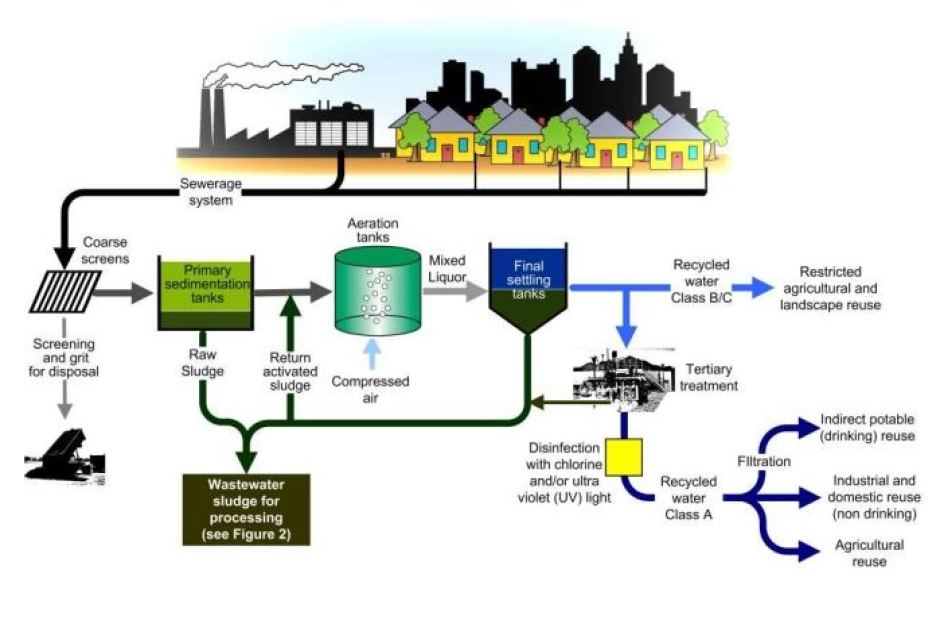Industrial Waste Water Treatment-- Tailored Solutions for Effective Wastewater Treatment
Industrial Waste Water Treatment-- Tailored Solutions for Effective Wastewater Treatment
Blog Article
Key Strategies in Industrial Waste Water Therapy Processes
The treatment of industrial wastewater is a crucial aspect of ecological monitoring, including a range of techniques developed to alleviate the influence of impurities. Innovations in technologies such as membrane filtration and advanced oxidation procedures use cutting-edge services for improving therapy efficiency.
Physical Therapy Techniques
Exactly how properly can physical treatment methods resolve the complexities of industrial wastewater? Physical treatment methods play a pivotal function in the initial phases of wastewater administration, focusing mostly on the removal of solids and large particulates. Methods such as purification, flotation protection, and sedimentation are vital for minimizing the concentration of put on hold solids, thus boosting the efficiency of subsequent therapy processes.
Sedimentation entails the gravitational settling of solids, permitting for the splitting up of larger materials from the wastewater. This technique is specifically effective in making clear water prior to organic or chemical treatments.
Additionally, flotation approaches, which make use of air bubbles to raise put on hold solids to the surface for removal, work in treating wastewater with high focus of fats, oils, and greases. Overall, physical treatment methods act as a critical very first step in the extensive management of industrial wastewater, making sure that the load on subsequent treatment phases is reduced and boosting total therapy efficacy.
Chemical Therapy Techniques
While physical treatment methods lay the groundwork for reliable wastewater management, chemical treatment strategies are crucial for addressing the extra complex pollutants usually discovered in industrial effluents. These methods make use of various chemical agents to precipitate, counteract, or oxidize hazardous compounds, ensuring a more thorough removal of toxins.
One typical approach is coagulation and flocculation, where chemical coagulants such as light weight aluminum sulfate or ferric chloride are included to advertise the aggregation of put on hold particles. This procedure improves solid-liquid separation, reducing turbidity and improving water top quality. Furthermore, neutralization processes are used to change the pH of wastewater, using acids or bases to neutralize acidic or alkaline streams, respectively.
Oxidation-reduction responses play an essential role in derogatory organic pollutants and pathogens. Chemical oxidants like chlorine, ozone, or hydrogen peroxide are utilized to damage down complex natural compounds, making them less dangerous or more naturally degradable. Progressed oxidation procedures (AOPs) combine numerous oxidation methods to enhance contaminant removal efficiency.
Biological Treatment Processes
The performance of wastewater therapy is considerably improved by biological treatment procedures, which harness the all-natural metabolic tasks of bacteria to disintegrate natural issue and eliminate toxins. Industrial Waste Water Treatment. These procedures primarily include anaerobic and cardio digestion, each customized for particular sorts of wastewater
Cardiovascular therapy procedures use oxygen to sustain microbial growth, advertising the breakdown of organic pollutants into carbon dioxide and water. Usual approaches consist of activated sludge systems, where aeration tanks help with the mixing of wastewater with bacteria, and flowing filters, which urge biofilm growth on media surfaces.
On the other hand, anaerobic treatment processes occur in the absence of oxygen, utilizing anaerobic microorganisms to disintegrate organic issue, resulting in biogas manufacturing, a renewable power resource. Anaerobic digesters are usually utilized in industrial setups for this function, effectively minimizing the volume of sludge while generating beneficial biogas.
The selection of an organic therapy approach depends upon wastewater attributes, therapy objectives, and regulatory requirements. The integration of biological procedures in wastewater therapy not only improves contaminant elimination efficiency however likewise promotes sustainability by decreasing chemical usage and sustaining source recovery.
Advanced Oxidation Processes

Typical AOP methods consist of Fenton's ozonation, reagent, and photocatalysis. Fenton's reagent, a mix of hydrogen peroxide and ferrous iron, catalyzes the formation of hydroxyl radicals, making it efficient for treating wastewater containing phenolic substances and various other stubborn materials.
AOPs offer a number of advantages, including decreased sludge manufacturing and the capability to treat wastewater with high focus of natural contaminants. The application of AOPs requires cautious consideration of operational criteria and cost-effectiveness, guaranteeing that these advanced strategies are suitably incorporated into existing wastewater therapy systems.
Membrane Purification Technologies

Microfiltration works for getting rid of suspended bacteria and solids, while ultrafiltration targets smaller sized organic particles and infections. Nanofiltration links the gap between ultrafiltration and turn around osmosis, successfully removing divalent ions and natural compounds. Reverse osmosis gives the highest degree of filtration, made use of largely for check my blog desalination and removing mono-valent ions.
Membrane moved here innovations use countless benefits, including low power consumption compared to traditional treatment methods, modular layout for scalability, and the capacity for water recovery and reuse. However, obstacles such as membrane layer fouling and the need for routine maintenance need to be dealt with to make certain system efficiency. Generally, membrane layer filtration innovations stand for a crucial component of modern commercial wastewater treatment techniques, promoting sustainability and resource conservation in water administration.
Final Thought
In final thought, commercial wastewater treatment utilizes a diverse variety of methods, including physical, chemical, biological, and advanced approaches. Continued developments in these methods will certainly better improve the performance and effectiveness of wastewater therapy processes in industrial setups.
The treatment of industrial wastewater is a crucial facet of environmental administration, including a variety of strategies created to mitigate the effect of pollutants.Just how effectively can physical treatment approaches resolve the intricacies of industrial wastewater?Advanced oxidation procedures (AOPs) stand for an innovative technique in industrial wastewater therapy, created to properly degrade natural toxins that are typically immune to standard therapy techniques (Industrial Waste Water Treatment).In verdict, industrial wastewater treatment uses a varied range of methods, including physical, chemical, organic, and advanced his explanation methods. Continued innovations in these methods will certainly additionally boost the effectiveness and efficiency of wastewater therapy procedures in commercial setups
Report this page